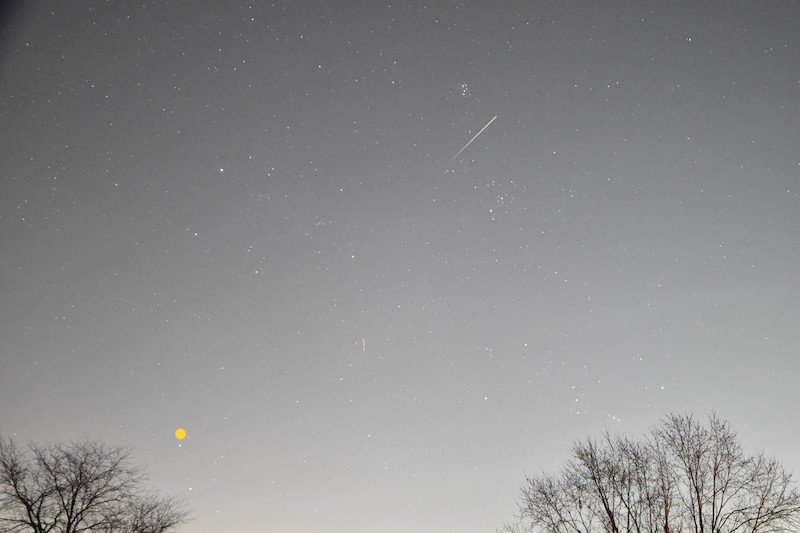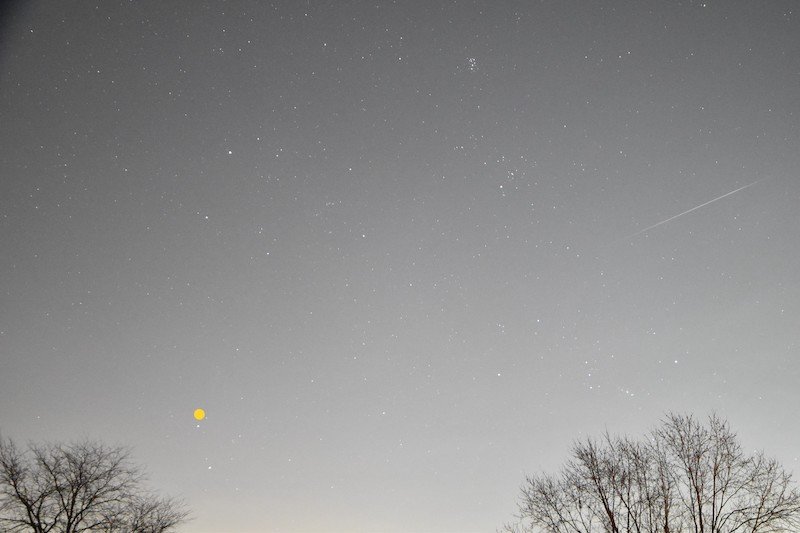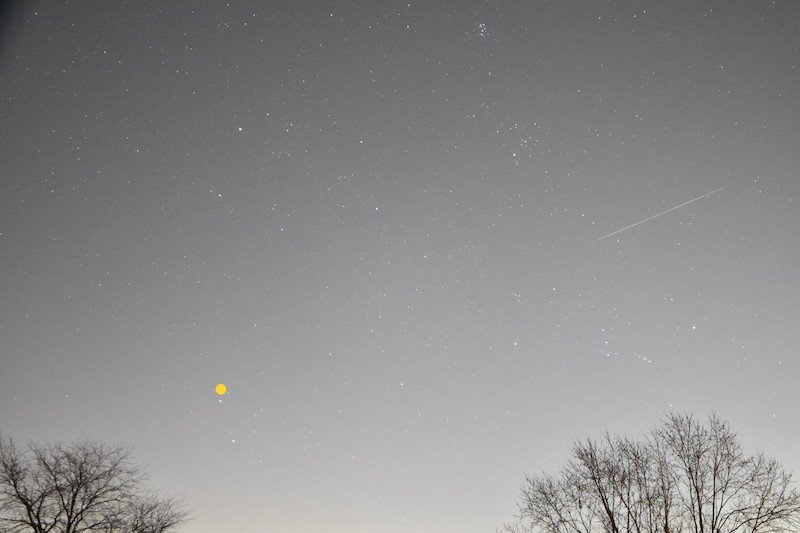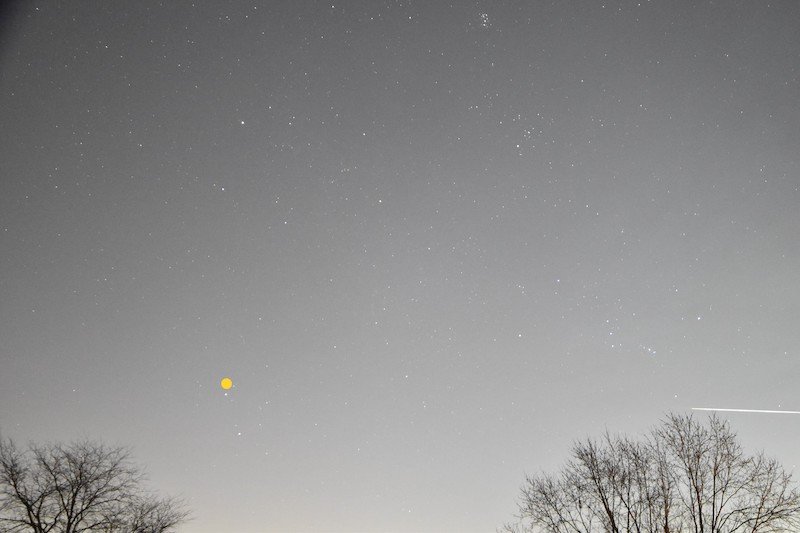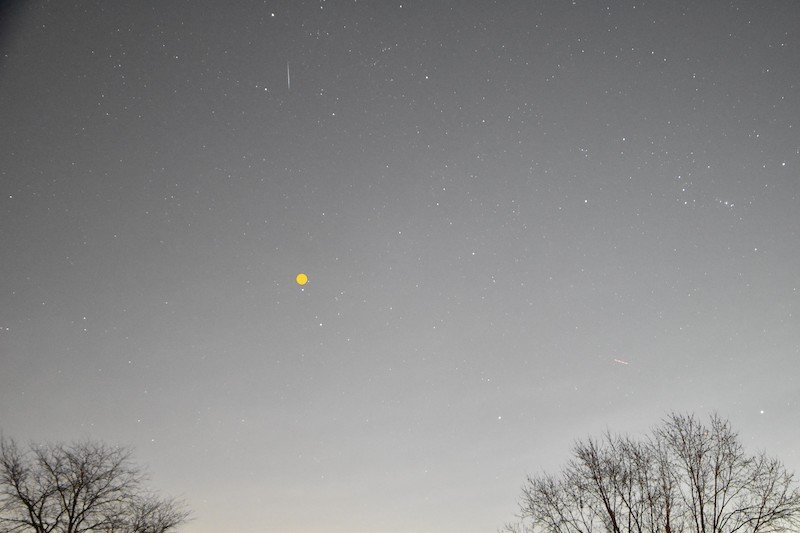
Responding to Flat-Earther Claims Regarding Meteors
Abstract
Meteors, colloquially known as shooting stars or falling stars, are brief, fast, streaks of light in the sky that superficially resemble stars. The conventional understanding of meteors is that they are debris from asteroids or comets that suffer collisions with the earth’s atmosphere. Before undergoing collisions with the atmosphere, the debris are called meteoroids. Both meteoroids and the earth orbit the sun. The collisions are due to the relative orbital motions of the meteoroids and the earth. The relative speeds of the meteoroids range between 7 and 44 miles per second. About 60 miles up, the air is thick enough to quickly slow the motion of meteoroids. Meteors’ brief flashes of light come from the conversion of their meteoroids’ kinetic energy into heat. Most meteoroids are consumed by the collision with the earth’s atmosphere, but any fragments that reach the ground are called meteorites.
Meteoroids can approach the earth’s atmosphere from any direction, from grazing incidence, where the meteoroids move tangentially to the earth’s atmosphere, to perpendicular incidence. However, a meteor trail’s appearance depends upon one’s location with respect to the trail. If one is directly in the line of the trail, the meteor will appear as a bright spot. I may have photographed one of these a few months ago while taking photographs for a time-lapse video—one image had what appeared to be a star where no star of that brightness was. On the other hand, if one is located off the line of the trail, the meteor will appear as a streak. The farther one is from the line of a meteor’s trail, the greater the length of the observed trail.
Flat-earthers refuse to accept the reality of what meteors are because it contradicts their chosen cosmology, where there is no orbital motion.
There is abundant evidence to support this understanding of meteors, so I see no reason to question it. However, flat-earthers refuse to accept the reality of what meteors are because it contradicts their chosen cosmology, where there is no orbital motion. Furthermore, flat-earthers believe there is a dome over top of the earth, so there can’t be collisions of meteoroids from space with the atmosphere (in the flat-earth cosmology, space does not exist). To support their denial, flat-earthers claim that if the conventional explanation of meteors is correct, then from time to time, we ought to see meteors that appear to move upward. Flat-earthers assert that since no meteors have ever appeared to move upward, the conventional explanation for meteors must be wrong. Let us examine these two claims.
Claim Number 1
Is it true that in conventional cosmology meteors must occasionally appear to move upward? Yes. Consider a meteoroid that approaches the earth’s atmosphere at a grazing angle. During the brief, brilliant trail of such a meteor, the earth’s gravity would cause the trail to curve slightly downward toward the ground, but the amount of curvature is so small as to be ignored. Hence, the meteor trail would be nearly tangent to the earth’s surface and layers in the earth’s atmosphere. Though its altitude is much higher than aircraft, the path of a tangentially moving meteor is similar to that of a high altitude aircraft. If an aircraft’s velocity has a component in the direction of an observer, the aircraft will gradually appear higher in the sky as the plane approaches the observer. Once the aircraft reaches its minimum distance from the observer, the plane will appear to descend. In a similar manner, a near-grazing meteor trail that has a velocity component toward the observer will appear to rise. Hence, the flat-earthers’ claim that with the conventional explanation of meteors, we ought to occasionally see meteors appear to rise is true. Of course, most meteors won’t appear to rise, but at least a few meteors will.
What do flat-earthers predict within their model about the existence of meteors apparently moving upward? Like so many other things, flat-earthers have no answer to the phenomenon of meteors, so getting a prediction from flat-earthers is well-nigh impossible. Since nothing can penetrate the dome over the earth, nothing from outside can produce meteors. Some flat-earthers appear to entertain the notion that meteors are things that fall from the dome from time to time. If that is the case, then there would be no expectation of meteors that appear to rise. But I suspect that few flat-earthers would endorse this explanation for meteors. Flat-earthers generally don’t give any physical (tangible) explanation for celestial bodies, such as the sun, moon, planets, and stars. Rather, most flat-earthers assert that celestial bodies are “just lights in the sky.” Consequently, I would expect that many flat-earthers would say that their “model” has no difficulty explaining upwardly moving meteors—they are simply brief lights that seem to move upward very quickly. Therefore, to flat-earthers, the search for upwardly moving meteors is a crucial test for the conventional explanation, but not for the flat earth. How convenient.
Claim Number 2
Do meteors ever appear to move upward? As someone who has seen thousands, perhaps tens of thousands, of meteors, I can testify that the unequivocal answer to that question is yes. Anyone who has seen many meteors knows that meteors occasionally appear to move upward. So why do flat-earthers keep repeating the lie that no one has ever seen an upwardly moving meteor? I can only conclude that one flat-earther made this claim, and other flat-earthers uncritically repeated the claim without spending time to check this claim out for themselves. That’s a pretty poor performance for people who claim to follow the zetetic philosophy of not taking anyone’s word for anything but investigating things for themselves.
One of the best opportunities to determine whether meteors ever appear to move upward is during a meteor shower. Meteor showers occur throughout the year when the earth crosses the orbits of comets. The debris shed from a comet as it nears the sun each orbit gets scattered along the comet’s orbit. As we pass through a comet’s orbit each year, the debris (meteoroids) in the orbit produce a brief rise in meteor activity. Even more important, due to perspective (a word that flat-earthers love), the meteors from a shower appear to diverge from one small region in the sky. We call this spot the shower’s radiant. Shower meteors can appear anywhere in the sky, but their trails all trace backward to the radiant. The radiant is the direction in space from which meteoroids appear to come.
More meteors are visible in the early morning hours rather than the evening because in the evening we are on the backside of the earth and see only meteors that overtake the earth. Therefore, it is generally recommended to watch meteor showers in the early morning rather than the evening because that is when one may see the greatest number of meteors. However, for our purposes, it is best to watch meteor showers in the early evening because, with most meteor showers, the radiant will be very low in the sky or even below the horizon in the early evening. Under that circumstance, if one faces the direction of the radiant, many of the meteoroids will strike the atmosphere at grazing angles and may produce meteors that appear to rise. The Perseid meteor shower in early mid-August is one of my favorites because it produces many meteors, and the weather is very comfortable for Northern Hemisphere viewers. In recent years, I have encouraged flat-earthers to watch the Perseid meteor shower in the evening to test their claim, but I don’t think any flat-earthers have taken up my challenge. Over the past several years, I’ve attempted to photograph the Perseids early in the evening, but I’ve had difficulty capturing enough meteors to make a good case.
Photographic Evidence
There are other, dependable meteor showers, such as the Geminids in mid-December. Because December is the beginning of winter in the Northern Hemisphere, this is not the most comfortable season to observe a meteor shower, so I’ve never spent much time watching the Geminid meteor shower. In recent years, there has been a marked increase in activity in the Geminid meteor shower, now usually surpassing the Perseid shower in the number of meteors seen. Another advantage is that the Geminid meteor shower is known for producing many bright meteors, which can make capturing photographs of them feasible, even in light-polluted skies.
The moon was dark during the 2023 Geminid shower, and the weather in Northern Kentucky was mostly clear on two of the peak nights, so I took advantage of the situation by taking photographs of the sky most of the night, hoping to capture Geminid meteors. I would have liked to have driven two hours to a relatively dark location to do this, but circumstances did not permit, so instead, I set up my camera on a tripod on the deck in the back of my house in suburban Cincinnati. Light pollution is a problem, which caused me to decrease my standard 13-second exposure times for such photographs. On the night of December 13–14, 2023, I took more than 3,300 photographs, and on December 14–15, 2023, I took more than 5,500 photographs. I mounted my Nikon D-5600 camera on a tripod, with my 14 mm f/2.8 lens attached to the camera. Since meteors typically last a second or less and their light is spread out, I set the ISO to 6400. On the first night, I set the exposure time for each photograph to five seconds. Upon examining the photographs the next day, I thought the sky brightness was a bit great, so on the second night, I reduced the exposure time to four seconds. On either night, each exposure was followed by a dark exposure and a one-second delay before taking the next photograph. The sequence would run for a little more than three hours unattended, so there were a few short breaks to restart sequences. Furthermore, several battery changes were required either night, introducing additional delays. I used a lens heater to prevent dew formation.
I went through all the photographs looking for meteors. With more than 8,800 photographs, that may sound like a Herculean task, but it is not as difficult as it sounds. In recent years, I have taken many photographs of the Perseid meteor shower, and I have developed a technique for rapidly examining the photographs for meteors. I visually scan through the images about one per second, looking for any obvious streaks. Aircraft are easy to pick out because they often have several lights, including red and green as well as white, and they show up in multiple images. Early in the evening and before dawn, satellites show up. Satellites only appear white, but like aircraft, satellites tend to show up in multiple images. On the other hand, meteors appear in single photographs, and their brightness often changes along their trails. With practice, it is relatively easy to spot meteors and distinguish them from aircraft and satellites.
I identified 20 meteors in the photographs of the first night. I had pointed the camera to the northeast, so the radiant was not in the field of view in any of the photographs, but by identifying stars in each image, I was able to estimate the direction of the radiant to establish whether meteors likely were Geminids. Of the 20 meteors recorded, I determined that 15 were Geminids. On the second evening, I pointed the camera toward the east, where the radiant of the meteor shower was near the horizon at dusk but eventually rotated upward and out of the field of view. I found 26 meteors in the photographs on the second night, 22 of which were Geminids. Therefore, I identified a total of 37 Geminid meteors over the two nights.
Of the photographs from the second night that contained Geminids, I selected the 13 photographs that also had the radiant of the Geminid meteor shower in their fields of view. The photographs are shown in Figures 1–13. The slight obstruction in the upper left corner of each photograph is part of the lens heater. Since one of the 13 photographs recorded two Geminids, there are a total of 14 Geminids in these photographs. On each of the photographs, I marked with a yellow dot the approximate location of the radiant of the Geminids. You can confirm the location of the radiant in each photograph by comparing this finder chart to my photographs. To confirm that I have correctly identified the Geminid meteors, you can easily trace each of the 14 meteor trails back to the radiant. Keep in mind that I used a relatively wide-angle lens that has some barrel distortion, so in some cases, the meteor trails depart slightly from linearity with the radiant.
This is direct evidence that meteors sometimes do appear to move upward, contradicting the flat-earther claim that meteors never appear to move upward.
Of the 14 Geminid meteors, eight had an upward component, while four meteors had a downward component. Two meteors were nearly horizontal. This is direct evidence that meteors sometimes do appear to move upward, contradicting the flat-earther claim that meteors never appear to move upward.
Conclusion
Flat-earthers frequently claim that meteors never appear to move upward. To disprove such a universal statement requires only one counterexample (a white swan), one meteor appearing to move upward. I have produced photographic evidence of eight meteors that appeared to move upward. Therefore, the flat-earther claim that meteors never appear to move upward is falsified.
How might flat-earthers respond to the evidence I presented here? I’ve found that flat-earthers generally ignore the evidence that I publish. If flat-earthers were to engage with this new evidence, I could predict several possible tacks they might take. One would be to respond that since these are photographs rather than videos, there is no direct evidence that the eight meteors were moving upward—all eight meteors could have moved downward. The problem with this approach is that the other six meteors in these 13 photographs track backward to the radiant. Why would the eight go in the opposite direction and not pass through the radiant? Furthermore, most of the other 23 meteors I identified from the photographs appeared to move downward and could be traced backward to the radiant. The radiant for the Geminid meteor shower has long been established, and anyone who takes the care to test this for himself can readily determine where the radiant is.
Another approach could be to simply deny my data, asserting without evidence that I faked the images of the meteors in the photographs. Such baseless accusations are far too common among flat-earthers. According to Hitchens’ razor, there is no need to respond to such an accusation.
Another possibility would be for flat-earthers to recognize that the data I provided disproves this common flat-earther claim, leading to the conclusion that meteors do occasionally appear to move upward. While this would remove a supposed argument against the conventional explanation of things, by itself this evidence hardly threatens the belief that the earth is flat. As I stated previously, flat-earthers could simply claim that meteors are just brief, fast-moving lights in the sky that sometimes appear to move upward.
Answers in Depth
2024 Volume 19
Answers in Depth explores the biblical worldview in addressing modern scientific research, history, current events, popular media, theology, and much more.
Browse Volume
Answers in Genesis is an apologetics ministry, dedicated to helping Christians defend their faith and proclaim the good news of Jesus Christ.
- Customer Service 800.778.3390
- Available Monday–Friday | 9 AM–5 PM ET
- © 2026 Answers in Genesis

